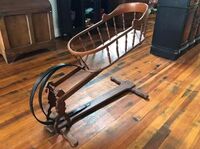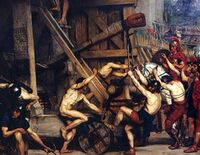Baby catapult
The baby catapult is not indeed a small or shoulder-fired catapult, but a catapult that uses babies as its ammunition. It was the mainstay of medieval armies, effective both as a siege weapon and, in smaller forms, as field artillery. There was no effective birth control in those days, so an infantryman found it most useful to spring the offspring at his enemy in wartime. And it was always a he, as women, like our modern Rosie the Riveter, were not combatants but relegated to manufacturing the ammunition. During the early modern period, the baby catapult was made obsolete by the development of the toddler trebuchet. In response to a salvo of babies, the enemy would traditionally use toys and chocolate to distract any of the ammunition who made it over the parapets.
Development
“I don't even care if your Dad's from Thebes”
Archaeological evidence shows that the earliest designs of baby catapults came about in the early fourth century BC, agreeing with evidence provided in accounts of the Battle of Leuktra (371 BC), in which the infamous Spar Supermarkets were defeated by the slightly less popular Thebans (from the city of Thebes, in Greece not Egypt). The spar space-hopper troops were, according to the chronicler Xylophone, "stopped by the sheer force of 1000 infants falling upon them at a great velocity."
Unfortunately, those baby catapults proved too expensive and required too much manpower to use on a regular basis. The technology remained unused until the Second Pubic War, when Anthony Hopkins was driven back from Rome. The Roman commander, Scorpio (Have you driven a ![]() lately?), utilised the woods surrounding the city to build forty catapults specifically for the launching of extra-loud babies. These did the trick, driving Hopkins's elephants to stampede through the Carthaginian lines killing many of Hopkins's finest units. Hopkins returned to Carthage taupe with embarrassment.
lately?), utilised the woods surrounding the city to build forty catapults specifically for the launching of extra-loud babies. These did the trick, driving Hopkins's elephants to stampede through the Carthaginian lines killing many of Hopkins's finest units. Hopkins returned to Carthage taupe with embarrassment.
Scorpio's catapult design was used regularly, the basic construction unchanging until superseded by the toddler trebuchet, followed by the Canon-copier cannon. The majority of these engines were torsional, often slapping the operators' backs harder than Mitch McConnell in the Senate. A small woman at the firing range complaining about her weapon's kickback has nothing on them. The payload bay at the top of the throwing arm was of differing shapes depending on the age of the ammo.
Notable uses
- 1096 The First Crusade — After Pope Urban III preached a crusade to seize the Holy Land for Christendom from the Islams, huge armies of carpenters and militaristic midwives began to build the catapults and procure the ammunition that would be necessary in the taking of such cities as Antioch, Jerusalem, and Topeka. Despite the use of scrummage, machetes, and drop goals, the Saracens were no match for the baby-assisted crusaders.
- 1204 The Fourth Crusade (first conquest of Constantinople) — The Dog of Venice made use of the catapults during his sea-borne siege. The catapults were placed on the tops of towers at the forecastles of his galleys, launching the babies over the impressive sea walls and into enemy territory.
- 1415 Agincourt — Despite being hugely outnumbered by French cavalry, Henry V was able to induce a shock defeat by use of the English longbow. The decisive artillery behind the Strongbow Super Longbows was a trio of baby catapults, able to fire both fetuses and live births, destroying the French rear.
- 1462 Ottoman conquest of Lesbos — Used female dominatrix babies.


